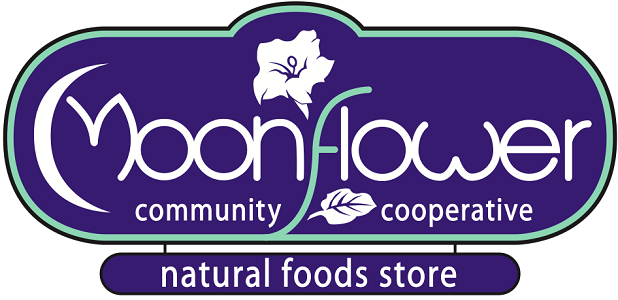In the arid southwest, any gardening or farming endeavors require a heavy investment in the soil. The often sandy or compact clay soil present throughout our region benefits from lots of organic amendments and a substantial investment of time and labor. However, the initially challenging work needed to build soil fertility will yield substantial rewards. Jessica Soza, a professional gardener with nearly 15 years of experience developing permaculture projects and food forests, offered up some soil building wisdom during her class at Moonflower Co-op on May 22nd.
Jessica began her presentation with an eloquent description of soil. “It’s like the ocean,” she suggested, “there’s a ton we don’t know about [it], and there’s a ton of life under our feet.” She stressed the importance of the subterranean world, reflecting on the notion that 90 percent of what we see above ground is influenced by the characteristics and dynamics of the soil. Soil is valuable and precious, and about 500-1,000 years is required to produce a mere inch of topsoil. Jessica remarked on the ubiquitous influence of soil in our lives, emphasizing that “the food we eat comes from the soil, [and the] water we drink is filtered by the soil.” With a genuine chuckle, she reminded that audience that “soil is everything.”
Over millenia, soil has developed from numerous tiny processes coming together to create vastly complex relationships. Therefore, our interactions with our soil must continuously enhance and facilitate these relationships rather than dismantle them. Jessica suggests that building and protecting these relationships can create an environment which sequesters carbon instead of burning it, regenerates life instead of squandering it, and offers up food for the community without ultimately robbing the soil of its value. Therefore, crafting healthy, living soil can strengthen both ecological and community resilience.
Soil webs offer an abstract glimpse into these complex below-ground relationships. They incorporate the influence of mammals, birds, invertebrates, protozoa, microbes, bacteria, organic matter, fungi, and root exudates. Their interactions facilitate the processes of bioavailability, decomposition, communication, and nutrient uptake rates. A self-sustaining soil web will lead to productive, fruitful gardens and growing spaces.
A period of observation of the desired growing space is needed in order to create a self-sustaining soil web and support these complex relationships. One of the twelve principles of permaculture design, observation provides the eager gardener, farmer, or permaculture designer with time to understand the nature of their site. Understanding the history of the land and other important factors such as slope, average wind speeds, sun and shade exposure throughout the day, seasonal temperatures, precipitation levels, and soil nutrient levels should inform the site plan. Observation also includes an analysis of the time, resources, and labor needs required to develop the land in a regenerative way.
The bulk of Jessica’s presentation focused on several specific techniques for building soil informed by the principles of permaculture and French biointensive gardening. She compared tilling and no-till methods and explained the processes and benefits of sheet mulching, double digging, hugelkultur, and combining methods intelligently. Regular tilling of the soil can result in soil compaction, topsoil erosion, and disruption of soil web relationships. However, Jessica cautioned the audience, encouraging them to stay away from dogmatic thinking. Focusing on one’s specific site, abilities, and available resources will heavily influence the decision to choose one method or the other. For example, some challenging sites may benefit from some initial tillage in order to break up hardpan soil and allow for the penetration of organic matter and other soil amendments.
No-till growing methods minimize soil disturbance and encourage robust soil relationships by working in harmony with natural soil processes. Growers can ditch gas-powered tilling equipment, such as rototillers, and slowly expand their garden using forks or broadforks. Forks or broadforks can open up and infiltrate the soil without excessively disrupting it from mixing, slicing, and turning over. Cover cropping and crop rotation also factors prominently into the no-till process. Cover crops, such as rye grass, buckwheat, peas, and clover, can be grown, chopped, and dropped in their place to incorporate green manure into the growing space. Utilizing the crop rotation process, such as seeding nitrogen-fixing beans after a planting of fruit-bearing crops, provides an ecologically sound alternative to growing the same crops in the same place and depleting precious soil nutrients.
The no-till methods of sheet mulching, double digging, and hugelkultur offer numerous benefits for the soil, including the slow release of nutrients. Sheet mulching serves a dual purpose: weed suppression and a steady supply of organic matter. Soil must be opened with a fork or broadfork and amended with manure, kelp, and/or other nutrient-dense organic materials. The amended soil should then receive a generous watering and covered with a thick, overlapping layer of cardboard to prevent the infiltration of noxious weeds. The cardboard layer should receive a substantial amount of water in order to allow the cardboard pieces to adhere. Add a thick layer of organic matter on top of the cardboard layer, and follow this with a final watering. Planting can occur within the sheet mulched area by cutting out spaces in the cardboard.
Double digging offers instant gratification in a struggling growing space in desperate need of soil fertility. This method is certainly labor intensive but offers immediate rewards in the form of deep, fluffy, nutrient-rich soil. After selecting a small section of land to cultivate, dig out a shallow trench, and place this soil to the side. Fork up the second layer in the section and add soil amendments, such as manure or compost, and return the initially removed top layer to the area. The aeration of the soil and addition of soil amendments will dramatically expand the bed’s depth and essentially form a raised bed.
Hugelkultur, historically utilized in German and Eastern European cultures, incorporates tree stumps, branches, and other massive amounts of plant biomass and offers the long-term, slow release of carbon, microbial activity, water, and more into the soil. Hugelkultur in arid regions may benefit from a sunken design, while humid regions benefit from the traditional raised hugelkultur beds. Decaying, mycelium-rich chunks of wood can inject the soil with beneficial microbial life and nutrients over a long period of time. The bank of carbon-rich materials can also easily absorb and retain moisture.
Finally, intelligent combining of any of these techniques, such as double hugel digging, can offer additional benefits depending on the site, available resources, and the desired outcome of the gardening project. Double hugel digging, for example, would consist of burying woody, carbon-rich materials alongside the soil amendments during the double digging process.
The arid high desert climate in our community presents a challenge to any eager gardener, but initial diligent efforts to cultivate healthy, living soil pay off dramatically over time. Utilizing intensive methods of permaculture to regenerate our soil can provide our community with building blocks to grow nutrient-dense food and forage plants, expand our pollinator gardens, reduce our dependence on industrially grown foods, and engender collaborative community efforts. Share this information with friends, family, neighbors, and community members, and consider starting your own community-driven permaculture project, incorporating food-sharing, work-trading, storytelling, skills-sharing, and much more.

